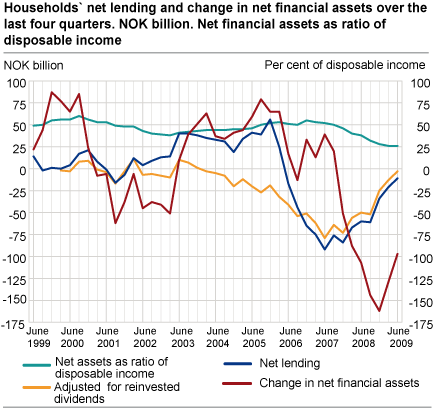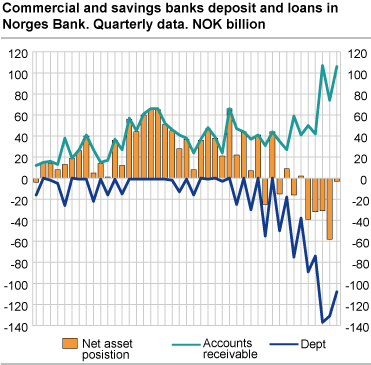Content
Published:
This is an archived release.
Households had holding gains
Households and non-profit institutions serving households had holding gains in the second quarter of 2009, after suffering huge holding losses from the autumn of 2007. The accrued holding loss from the end of the second quarter of 2007 was reduced by NOK 29 billion to NOK 133 billion.
Households’ net lending was NOK -11 billion in the last four quarter period, which is NOK 10 billion higher than in the period up to the first quarter of 2009. Holding losses amounted to NOK 86 billion, and combined with negative net lending this contributed to a reduction in net financial assets of NOK 97 billion in the last four quarter period. Households’ net financial assets amounted to NOK 282 billion at the end of the second quarter of 2009.
Households consolidated their financial position
Borrowing declined significantly in the last quarter compared with the same quarter in 2008, while the fall in financial investments levelled out. Households’ activities in securities markets have recovered over the last two quarters, after several years with downward sales of quoted securities. The acquisition of quoted shares and mutual fund shares in particular has increased. The development in the financial accounts is consistent with the movement in the non-financial accounts in the first quarter of 2009, where households increased their savings, while the fixed capital formation declined. The total picture indicates that many households are consolidating their financial position also in the second quarter of 2009.
Banks in net borrowing position to Norges Bank
Normally the commercial and savings banks are in a net assets position to the Central Bank. Due to the financial turmoil, the Central Bank has supplied the banking system with liquid means beyond standard, inter alia by lending (F-loans) and foreign currency deposits. At the end of the second quarter of 2009, domestic banks were in a net borrowing position to the Central Bank. Assets amounted to NOK 106 billion, while liabilities amounted to NOK 108 billion.
Central government’s net financial asset at a record high level
Central government’s net lending in the four quarter period up to the second quarter of 2009 is calculated to NOK 373 billion, which is down NOK 81 billion from the period up to the first quarter of 2009. The development is explained by falling investments in the Government Pension Fund - Global due to lower revenues from oil and gas activities at the end of the last four quarter period. The quoted development in securities markets has resulted in huge holding gains in central government. Capital gains contributed to NOK 286 billion and central government’s net financial assets increased to a record high level of NOK 3 437 billion at the end of the second quarter of 2009.
Local government reduced its deficit
The local government’s net lending over the last four quarter period was NOK -25 billion, compared with NOK -27 billion in the period to the first quarter of 2009. This development reflects, among other factors, growth in municipalities’ deposits. The development is explained by the fiscal package of measures which were passed by parliament in February this year and which has supplied municipalities with extra financial resources. The local government has in the last four quarter period borrowed NOK 41 billion, which is about NOK 1 billion more than in the previous period.
Net financial assets abroad are increasing
Norway’s net foreign assets were calculated to NOK 1 760 billion at the end of the second quarter of 2009. This is up by NOK 324 billion from the end of the first quarter of 2009, when net foreign assets were calculated at NOK 1 436 billion. In the last quarter, Norway’s net lending abroad was NOK 95 billion, at the same time as Norway achieved net holding gains towards the rest of the world of NOK 230 billion. Huge holding gains are explained by a rise in exchange rates in global securities markets.
| 2. quarter 2007 | 3. quarter 2007 | 4. quarter 2007 | 1. quarter 2008 | 2. quarter 2008 | 3. quarter 2008 | 4. quarter 2008 | 1. quarter 2009 | 2. quarter 2009 | |||||||||||||||||||||||||||||||
|---|---|---|---|---|---|---|---|---|---|---|---|---|---|---|---|---|---|---|---|---|---|---|---|---|---|---|---|---|---|---|---|---|---|---|---|---|---|---|---|
| Financial assets | 5 366 | 5 367 | 5 531 | 5 387 | 5 507 | 5 812 | 6 512 | 5 943 | 6 163 | ||||||||||||||||||||||||||||||
| Liabillities | 4 071 | 4 116 | 4 277 | 4 136 | 4 269 | 4 368 | 4 867 | 4 507 | 4 403 | ||||||||||||||||||||||||||||||
| Net financial assets / net financial wealth | 1 294 | 1 251 | 1 254 | 1 251 | 1 238 | 1 445 | 1 645 | 1 436 | 1 760 | ||||||||||||||||||||||||||||||
| Change in net financial assets / net financial wealth | 13 | -43 | 3 | -3 | -14 | 207 | 200 | -209 | 324 | ||||||||||||||||||||||||||||||
| Other changes | -54 | -138 | -114 | -107 | -139 | 85 | 56 | -284 | 230 | ||||||||||||||||||||||||||||||
| Net lending | 67 | 95 | 117 | 104 | 125 | 122 | 144 | 74 | 95 | ||||||||||||||||||||||||||||||
DefinitionsNet lending as defined in non-financial accounts (capital account) = savings + net capital transfers - net acquisition of non-financial assets Net lending as defined in financial accounts = net acquisition of financial assets - net incurrence of liabilities Savings is non-consumed income and can be invested in financial or non-financial assets. If savings exceed non-financial investments, a sector has a surplus of funds and becomes a net lender to other sectors. In the financial transaction account, this means that the sector acquires more financial assets than liabilities. On the other hand, if savings are less than non-financial investments, investments have to be funded either by selling financial assets or incurring debts. Household investments in non-financial assets mainly reflect the purchase of new housing and fixed investments by unincorporated enterprises. They typically finance substantial parts of these investments by incurring debt in the form of loans. Net financial assets (net financial wealth) = total financial assets - total liabilities The financial balance sheet shows the financial position of a sector at the end of the reference period and is broken down into the categories of financial assets and liabilities. Insurance technical reserves, currency and deposits are the predominant assets held by households, while loans provided by financial corporations (banks etc.) constitute the main proportion of liabilities. Changes in net financial assets = net lending + other changes in assets, net The change in the financial balance sheet during the reference period is a result of accumulated financial transactions and other changes in assets. The latter category mainly reflects revaluations due to changes in market prices of financial instruments. |
Contact
-
Torbjørn Cock Rønning
E-mail: torbjorn.cock.ronning@ssb.no
tel.: (+47) 97 75 28 57
-
Jon Ivar Røstadsand
E-mail: jon-ivar.rostadsand@ssb.no
tel.: (+47) 21 09 43 69
-
Marit Eline Sand
E-mail: marit.sand@ssb.no
tel.: (+47) 40 90 26 74


